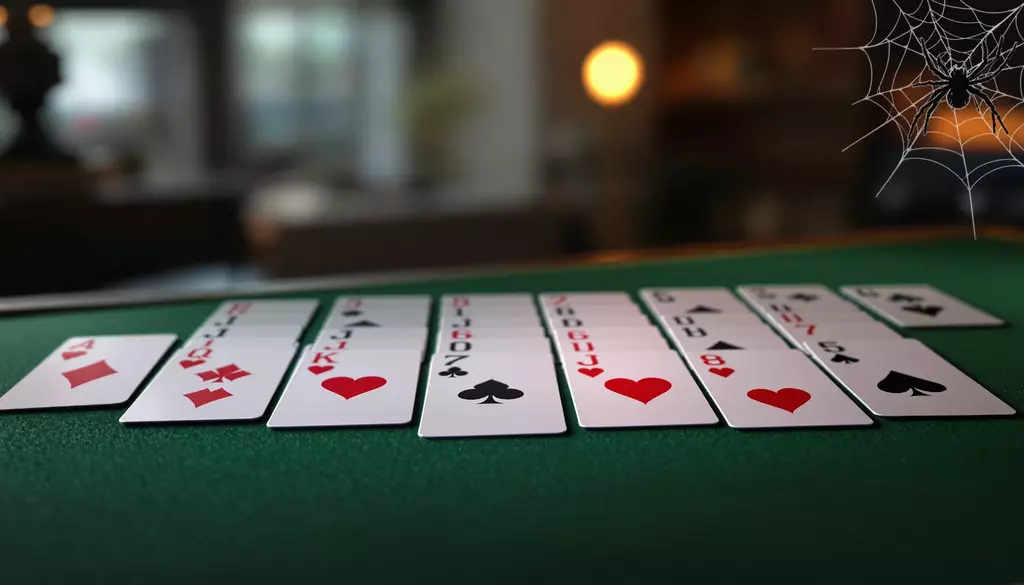How to Play Spider Solitaire

Spider Solitaire has gained a reputation as a more intricate and strategic cousin of the ever-popular Klondike. Designed to challenge your ability to plan multiple moves ahead, Spider rewards careful thinking and patience. In this guide, we’ll break down the basic setup, rules, and winning strategies. We’ll also touch on how Spider differs from Klondike and explore a few other popular solitaire variants you might enjoy.
What You’ll Need
You’ll need two standard 52-card decks (104 cards in total) if you’re playing physically, or simply load up a digital version of the game online.
Initial Setup
- Tableau Columns: Deal out 10 columns of cards. The first four columns each get six cards, and the remaining six columns each get five cards. Only the top card of each column is face-up.
- Stock Pile: The remaining cards form the Stock, which you’ll use to deal new rows of cards onto the tableau when you run out of moves.
- No Initial Foundations: Unlike Klondike, Spider doesn’t start with any Foundation piles. Instead, your goal is to create complete sequences within the tableau and remove them as they form.
How to Play
- Building in the Tableau: Your objective is to arrange cards in descending sequences of the same suit from King down to Ace. For example: K, Q, J, 10, 9, 8, 7, 6, 5, 4, 3, 2, A (all spades).
- Moving Stacks: You can move any face-up card, along with all the cards stacked on it in proper descending order, to another column if it continues the descending sequence.
- Completing a Sequence: Once you form a complete descending suit sequence from King down to Ace, you can remove that entire sequence from the tableau. Eventually, you want to remove all cards.
- Dealing from the Stock: When you run out of moves, deal one card onto each column from the Stock. Keep in mind that you can’t deal from the Stock if there are any completely empty columns—the game rules generally require that every column must have at least one card before you deal again.
Game Variations Within Spider
- One Suit: Often considered the easiest form, using only one suit makes it simpler to form complete sequences.
- Two Suits: This is the intermediate difficulty setting, often Hearts and Spades, making it trickier to keep track of suits.
- Four Suits: The hardest version, using all four suits demands meticulous planning and patience.
How Spider Differs from Klondike
- More Complex Setup: Klondike uses one deck and seven columns, each with a varying number of face-down cards. Spider doubles the deck count and spreads cards more widely.
- Suits Are More Critical: In Klondike, you alternate red and black suits to build the tableau. In Spider, all cards in a sequence must be of the same suit to remove them.
- No Initial Foundations: Klondike guides you toward building four Foundations (one per suit) starting with Aces. Spider skips this structure; your main task is to build and remove complete suit sequences directly from the tableau.
- Strategy & Difficulty: Spider typically offers a more challenging experience than Klondike. With multiple suits and a larger card pool, Spider requires longer-term planning and can feel more like a puzzle.
Other Popular Solitaire Variants
If you enjoy Klondike and Spider, you might want to explore other notable solitaire variants:
-
FreeCell: Every card is dealt face-up from the start, and you have four “free cells” as holding spots. It’s a game that relies heavily on logic and forward planning, rather than luck.
-
Pyramid Solitaire: Cards are laid out in a pyramid shape. Your goal is to pair cards that sum to 13, removing them until you clear the pyramid. It’s a simpler but luck-dependent puzzle.
-
Yukon: Similar to Klondike but without a strict need to uncover cards by building foundations first. You can move entire stacks even if not all cards are exposed. This adds complexity but gives you more freedom.
-
Golf Solitaire: You clear rows of cards by moving them to a foundation pile if they are one rank higher or lower than the top card of the foundation. It’s a faster-paced variant that rewards quick thinking.
Strategies for Spider Success
- Focus on One Suit at a Time: Try to form complete sequences in a single suit. Mixing suits makes it harder to free up full runs.
- Clear Columns Early: Aim to free columns to give yourself more maneuvering space. An empty column can hold entire sequences and help you reorganize.
- Conserve Your Stock: Don’t rush to deal from the Stock. Make as many moves as possible before introducing new layers of complexity.
- Undo Moves (Digitally): If you’re playing on a digital platform that allows undos, use this feature to experiment with different moves, especially when learning.
Final Thoughts
Spider Solitaire is a dynamic and rewarding solitaire variant that encourages careful planning and foresight. Its differences from Klondike—requiring suit-ordered sequences and removing completed runs—make it both more intricate and more satisfying when you finally master it.
As you gain confidence, experiment with more suits and try your hand at other variants like FreeCell or Pyramid. Each offers its own mix of strategy and style, ensuring there’s always another challenge waiting for you in the world of solitaire.
Happy playing—and good luck untangling those cards!